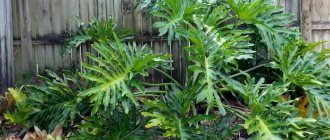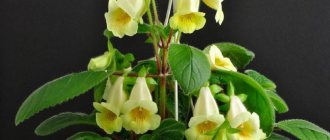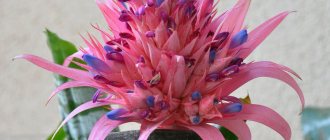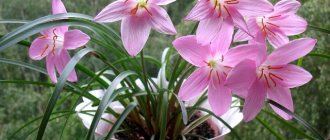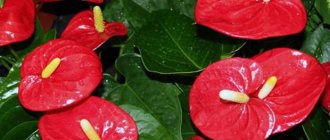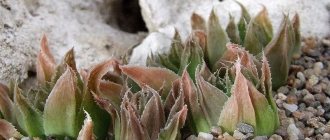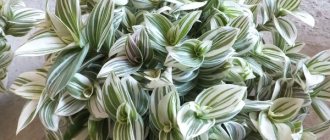Plants » Flowers
0
233
Article rating
Kira Stoletova
Tradescantia variegated is a perennial herbaceous plant from the genus of the same name. Flower growers have retained the former name Reo veil, derived from the name of a mythological character - a nymph. Native to the subtropical zones of Mexico and America. Widely cultivated in private gardening.
Tradescantia variegated is a wild plant.
Botanical characteristics
Tradescantia Reo is a herbaceous plant formerly part of the Commelinaceae family. In the natural environment, the wild crop is found in tropical forest belts, on the banks of natural reservoirs and sometimes grows on rocky slopes.
The decorative effect of the flower is provided by bright foliage, which can be plain green or purple, with a striped pattern of different shades, including white, pink and yellow.
Description:
- the stem is erect, the structure is fleshy, height up to 0.4 m, with numerous branches growing in random order, often under the weight of large foliage and in combination with lateral lighting they take on a hanging shape;
- leaves from 0.2 m long or more, about 6-8 cm wide, lanceolate in shape, horizontally directed, sessile position, elastic structure, glossy surface, the color of the upper part of the leaf blade is often dark green, the inner one is red-violet, present on the foliage striped ornament, on the surface there is orange and red hairy pubescence, the lower tier falls off as the plant grows, turning Tradescantia into a palm tree, resembling dracaena in appearance;
- the root system is fibrous, with thin villi roots;
- the inflorescences are small, white in color, attached to short pedicels, closed in a boat-like blanket, consisting of two or three leaves of a violet-colored bract.
With a properly organized microclimate, flowering is observed in any season throughout the entire calendar year, but in most cases it occurs in mid-summer.
Tradescantia capella: description of the variety and characteristics
Tradescantia capella: photo of the plant
Tradescantia capillata (Reo) is exactly the flower you need to bring exoticism into your life. It belongs to the Cammelinaceae family. His appearance is very extraordinary, he is lush, blooming and not difficult to care for.
Tradescantia capillata is a single-stemmed perennial, the stems of which are covered with incredibly interesting leaves in their color scheme and in large quantities. They are painted in two primary colors and complemented by various shades, which are unique to each variety. Basically, the inner surface of the leaves is painted in a rich purple hue, and the outer surface is green, which already adds exoticism to the flower. Reo is covered with foliage quite densely due to their large size. Their length can grow up to 30 centimeters, width 6, and thickness 50 mm.
This makes the flower not only very spectacular, but also boasts of retaining moisture and nutrients, which allow the plant not to be afraid of long periods of drought if it grows in natural conditions. Considering that the plant is of the Commeline family and its natural habitat is warm regions, it has practically no period of vegetative rest. So, if you provide it with comfortable conditions and properly care for it, then you can enjoy its exotic beauty all year round.
Reo's Birthplace:
In its natural habitat, Tradescantia tangulata can be found in the tropics with a temperate climate where the temperature ranges from +20 to +25 degrees. This plant comes from the tropical forests of the Northern part of the American continent, from the islands located between the south and north of America, as well as from Mexican territory. Growing in nature, it chooses places for itself in the humid tropics, on the edges of forests, along rivers and in poor red earth soils. By choosing similar living conditions for itself, the plant has become quite strong and can forgive the mistakes of young gardeners who grow it in comfortable home conditions.
There are different varieties of Rio, including:
- Striped (Rhoeo vittata) - this variety is distinguished from other light-colored stripes located on the outside of the leaf along it. Their edges are painted with thin and infrequent stripes, which become many times thicker in the center;
- Pink (Rhoeo stripe in pink) - this flower is painted with pink stripes, and the inner surface acquires a pink tint, which allows you to distinguish this variety from its “brothers”;
- Multi-colored (Rhoeo discolor) - this type of flower is covered with multi-colored stripes along the outside of the leaf, which makes the flower especially decorative.
Purchase and adaptation
The best time to buy a home flower is spring. Before the onset of the cold season, he will have time to adapt to new conditions.
Tradescantia variegated wild growing
When purchasing, you should pay attention to the appearance of the plant. In a healthy Tradescantia:
- bright rich color corresponding to the variety;
- there are no spots or signs of pests on the leaves;
- root system without damage.
Price - from 500 rubles.
Immediately after purchase, the flower crop is placed in quarantine, isolating it from other domestic flowers. In 2 weeks the plant undergoes adaptation, and during this time it is not replanted or fed.
Growing conditions
A sunny place is suitable for planting. Flower culture is intensively developing on the eastern and western sides of the room. When located in the north, it needs additional lighting; when placed in the south, shading during solar hours.
The capillary variety does not tolerate relocation well, so a permanent place of growth for it is chosen immediately.
For the full development of an indoor flower, a ready-made slightly acidic or acid-neutral substrate intended for growing decorative deciduous plants is suitable.
You can make the soil yourself by mixing fertile garden soil, peat mixture and river sand in proportions 5:3:2. To increase the aeration of the soil mixture, agroperlite or agrovermiculite is added.
Flower culture needs good drainage. Requires high humidity, at a level of 70-75%, and responds well to foliar spraying.
Temperature
Optimal mode:
- in summer - about 25°C;
- in winter - not lower than 10°C.
When grown on balconies and in open conditions, Tradescantia can withstand short-term temperature drops of up to 5°C, but such a drop causes the leaves to lose turgor. Does not tolerate drafts well.
Lighting
The flower is susceptible to prolonged exposure to the sun. Requires diffused light and shading from aggressive rays in order to prevent burns of the vegetative mass.
With a lack of lighting, it begins to stretch and changes the color of the leaves to pale. The optimal length of daylight is 8 hours or more. In winter, the lack of light is compensated by the use of artificial sources - fluorescent lamps.
Tradescantia capillary: care at home
Tradescantia capella: photo of the plant
It is not at all difficult to care for Tradescantia bedspread (Reo) when growing it at home; how this can be done so that the plant retains its decorative properties for a long time will be discussed below.
In order for the flower to grow healthy, it must be replanted every year, replacing the old soil with new soil by about a third. If the flower grows, it must be transplanted into a larger vase by transshipment. Rio loves light soils. You can prepare it yourself by mixing turf, which is located in the garden, sand collected from the river bank and peat, which is sold in all flower shops. It is possible, but not necessary, to improve the composition by adding leaf humus. The entire earthen mixture should consist of ingredients mixed in equal proportions. If desired, the mixture can be supplemented with agroperlite rock, which is formed when the lava of a volcano cools sharply. This component is good because it accumulates moisture in itself and gradually releases it to the plant, thus providing favorable humidity conditions. It is widely distributed and sold in stores.
When planting Tradescantia tangulata, you need to choose the right container, taking into account that the roots of the plant do not develop deep into the ground, but are directed in different directions. If the shape of the pot is chosen correctly, the plant will be especially lush. It is also very important to ensure good drainage, because even the most moisture-loving plant can begin to suffer from putrefactive diseases due to stagnation of water in the soil. You can ensure good drainage by using a layer of expanded clay or brick chips at the bottom of the pot.
Tradescantia capulata is a light-loving plant and it is important to remember this when choosing a place for it, but you should not expose the plant to direct bright sunlight. It will be comfortable for him to be in the west or east; the southeast and southwest are also suitable, but somewhat less so. If the flower is placed in the south of the house, then during the daytime, during the spring-summer season, it should be shaded, and in the autumn and winter, the more sun the plant receives, the better. Reo is not tolerant of drafts, so you should not leave it in a room where windows are open, especially close to it.
As for watering, there are no special tips here. In its natural habitat, Tradescantia capillata (Reo) grows where there are torrential rains that thin out the soil, which means that with good drainage, there is no need to worry about overflowing. But this does not mean that plants grown indoors should be filled with water. It will be sufficient to moisten the soil when it dries superficially. This will allow nutrients to remain in the soil longer. You should also not forget to spray periodically; before doing this, you need to wipe the leaves using a damp sponge. Such procedures will create the microclimate the plant needs.
The timing of fertilizing must be selected taking into account the ongoing watering. Fertilizers are applied at intervals of three weeks. As fertilizing, you can use ordinary complex fertilizers intended for growing flowers at home.
If the exotic flower is satisfied with its care, then it will be possible to observe the flowering throughout the year. However, it is worth noting that the plant did not gain its popularity for the beauty of its flowers. The shape of the buds is presented in the form of a boat, which is made up of two bracts, between which there is a bisexual inflorescence, which means insects are not needed to form seeds. It happens that a single inflorescence appears, but this happens extremely rarely.
Care
Planting and transplanting
For planting Tradescantia, in which the roots develop in diametrically opposite directions, a wide and not very deep pot is more suitable. Before filling the container with substrate, drainage from construction expanded clay or broken brick is laid on the bottom.
5 Tradescantia variegated
- The young plant is replanted annually, replacing the soil by 1/3;
- For an adult, a transplant every 3-4 years is sufficient.
The most suitable method is transshipment. The best time is from spring to early summer.
Watering
Tradescantia is unpretentious to watering, copes with short-term drought, but is susceptible to prolonged drying out of the soil.
Optimal watering regime:
- in spring and summer, at the stage of active vegetation, the flower crop is watered at intervals of up to 2-3 times a week, as the surface layer of the substrate dries 3-5 cm;
- in winter, combined with low temperatures, watering is reduced to 1-3 times a month.
Feeding
Homemade Tradescantia is fed in spring and summer, from March to August. Ready-made fertilizers designed for decorative indoor flowers are suitable for feeding. The frequency of application is once every 2 weeks.
Trimming
No formation required. Dry leaves and dried inflorescences must be pruned. Regular pinching of shoots will help ensure splendor and wide development of the flower crop.
Reproduction methods
At home, multi-colored tradescantia can be propagated by seeds or cuttings. An adult bush with a well-formed root system can be replanted by division.
Tradescantia variegated is a wild plant.
Seminal
The method is used infrequently, because it is difficult to obtain high-quality planting material. Seeds must be soaked before sowing, which increases their germination rate. Growth stimulants, for example, Epin, are added to the water.
Sow the seeds in the ground without digging, sprinkling the top with a layer of earth up to 2 mm thick. The plantings are covered with glass or plastic film to create a greenhouse effect and placed in a place where the temperature is maintained at about 20-22°C.
A flower crop is capable of self-propagation by seeds, throwing them out from the bracts as they mature, but this requires ideal conditions.
The first seedlings appear 3-6 weeks after sowing. When the sprouts sprout, the greenhouse begins to be regularly ventilated, and the dried soil is moistened with a spray bottle.
When the seedlings grow 2-3 leaves, the cover is removed, the plantings are planted in separate containers and care is provided as for an adult flower.
Cuttings
Breeding Tradescantia by shoots guarantees high results and preserves the quality characteristics of the parent plant. For propagation by cuttings, take lateral shoots that grow from the roots. They are cut off from the mother bush, the lower part is cleared of foliage and placed in water to form the root mass.
Spring is more suitable for cuttings. Rooting of autumn preparations takes much longer.
Tradescantia can also be propagated by cuttings cut from the main stems up to 15 cm long. They are rooted in water with activated carbon (1 tablet per 200 ml) or in a peat-sand mixture. The optimal temperature to adhere to for active rooting is at least 20°C.
After the roots grow to 1.5-2 cm in length, the cuttings are planted in individual containers and cared for as an adult plant.
Dividing the bush
Adult flowers aged 3 years and older, which have a well-formed root system, are suitable for division.
The parent bush is often divided in half, but if there are more shoots, there can be more than two divisions. The basic rule is that roots and shoots are preserved on each part.
Divided plants are planted in pots with a small depth, up to 2 cm.
Propagation of Tradescantia reo by cuttings
How to propagate reo from cuttings photo
Reo can be propagated by seed and vegetative methods (apical and lateral cuttings).
- Cuttings are preferably carried out in the spring, but at other times of the year the cuttings take root well.
- Using a sharp, disinfected knife, separate the lateral or apical cuttings from the mother plant and plant them in separate containers with moist sandy-peaty soil. Cover the top with a plastic cap. Maintain the air temperature at 20°C.
- You can also root simply in water: place the cuttings in water on a bright windowsill and in a couple of weeks the roots will grow, the plants can be planted in a permanent pot.
- Before rooting, it is advisable to soak the cuttings in a solution of root or heteroauxin (from several hours to a day). Remove the lower leaves from the cuttings to prevent them from rotting.
Rooted plants are planted in pots with soil suitable for replanting.
Treatment of diseases and pests
Tradescantia is one of the flower crops that rarely suffer from infections and are quite resistant to pests. Excessive watering and stagnant moisture sometimes lead to rotting of the root system, and an excess of direct sunlight causes burns.
Tradescantia variegated wild plant
The loss of a home flower's decorative properties is often associated with poor care.
| Type of lesion | Control measures |
| Powdery mildew or gray rot. Its appearance is caused by too much watering. | The affected vegetative parts are cut off, the plant is transplanted into a fresh substrate with preliminary disinfection of the pot, removing rotten roots. |
| The foliage turns yellow and becomes smaller, becomes pale, and the stems become elongated. Occurs due to lack of lighting. | The flower crop is moved to a place well lit by diffused sunlight. The required duration of daylight is provided with the help of additional lighting with fluorescent lamps. |
| The foliage turns brown and wrinkles. The main reason lies in the unsuitable temperature and composition of the water. | Water for irrigation is used that is settled, non-chlorinated, and at room temperature. |
| Shield. | Insects are removed manually by wiping the foliage with a soap solution (50 g per 1 liter of water). The plant is treated with an insecticidal agent, for example, Aktara. |
| The tips of the leaves dry out and turn brown. Occurs when surrounded by dry air. | The flower is sprayed on the foliage. Air humidifiers are installed in the room or the humidity is increased by any other available method. |
Medicinal properties
The plant is widely used in traditional medicine due to its beneficial chemical composition:
Is Tradescantia variegated a wild plant or not?
- for rheumatism, heated leaves are applied in the form of compresses, because it helps relieve pain;
- in case of damage to the skin, crushed tradescantia is used as a therapeutic mask;
- To treat intestinal disorders and normalize digestion, an infusion is made from Reo inflorescences by boiling for 0.5 hours and further straining.
Some peoples have found other uses for it.
- Mexicans use milky juice instead of blush, which is irritating to the skin and causes allergic dermatitis with redness.
- Among the inhabitants of Cuba, the beneficial liquid serves as a means of stopping bleeding of the gums, and they treat the upper respiratory tract with a decoction of the leaves.
Application
Tradescantia capella: photo of the plant
Traditional healers do not often use this flower to prepare healing potions, but this does not mean that the flower is not beneficial. There are recipes that can be used to prepare infusions that will help people suffering from rheumatism, intestinal problems, bleeding and various types of wounds on the skin. To treat rheumatism, you need to heat the leaves and make a compress from them for the joints. If there are open bleeding wounds on the skin, then the leaves should be washed, crushed, placed on the damaged area and bandaged. If you suffer from disintegration or intestinal bleeding, you can prepare a decoction by boiling the flowers for 20 minutes.
You can use infusions only after consulting a doctor.
Existing signs and superstitions:
It is believed that Tradescantia with its dual nature fills the house and its inhabitants with the energy to create and removes all aggressiveness. In addition, it gives confidence in achieving the goal and promotes the speedy completion of unfinished tasks. Some talk about the magical properties of indoor Reo, growing it as a talisman to protect against witchcraft. It is believed that the sign of Aquarius reveals in this purple miracle properties that help the circulatory and cardiovascular systems. The indoor flower is controlled by the celestial bodies of the Sun and Mars. The sun fills the house with an atmosphere of nobility and great spiritual beauty. Mars helps reduce aggressive energy.

